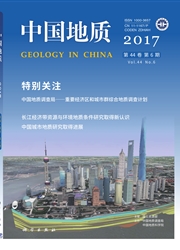

 中文摘要:
中文摘要:
大陆变形研究是大陆动力学的基本内容之一,对断裂构造及盆山演化进行研究是认识与了解大陆变形最直接有效的途径。中生代晚期—新生代,中国北方受到印度板块向北俯冲、太平洋板块向西运动与西伯利亚板块阻挡所导致的复杂构造动力系统的长期作用,地壳变形复杂,是研究大陆变形理想的天然实验室。本文在详细野外构造解析基础上,结合遥感与数字地貌技术、地震反射资料解释以及低温热年代学方法,通过对中国北方新生代断裂作用和山脉隆升历史研究,理清了断裂发育序次、断裂作用与构造应力场的对应关系,掌握了现今构造地貌格局东西差异的成因,并探讨了大陆变形的动力学机制。古新世—早始新世,中国北方普遍发育一组NNE向的断裂构造,该组断裂并非全区均匀发育,东部断裂规模较大,地貌特征明显,向西规模逐渐变小。NNE向断裂具有左行走滑的运动学特征,大致对应NW-SE向挤压应力场,推测NNE向左行走滑断裂的发育与新生代早期太平洋板块NNW向运动有关。NNE向断裂发育之后,东部渤海湾周边发育了NE向右行、NW向左行共轭走滑断裂,大致对应近EW向挤压应力场。西准噶尔地区发育了NE向左行、NW向右行走滑断裂,大致对应近NS向挤压应力场。东、西部的NE、NW向断裂都叠加在NNE向断裂之上,改造和破坏了早期NNE向断裂。本文推测东部后期断裂的发育与43~42 Ma太平洋板块运动由NNW转变为WNW向有关,而西部NE、NW向断裂发育与印度-欧亚大陆碰撞远程效应有关。随着印度板块持续北向运动并发生顺时针旋转,西部地区保持NNE向挤压应力场,发育了一系列NW、NNW向断裂。东部地区依然呈现近EW向挤压应力场。受到新生代以来各组断裂构造的影响,中国北方山脉和盆地呈现出线状与面状结合的网格状特征。磷灰石裂变径迹年龄统计显示,东部地区普遍经历?
 英文摘要:
英文摘要:
Continental deformation is one of the basic contents of continental dynamics. Researches on the faults and basin-mountain evolution are the most direct and effective way to understand the continental deformation. During the late Mesozoic—Cenozoic, northern China was long influenced by northward subduction of Indian plate, westward movement of Pacific plate and blocking of Siberia plate. The crustal deformation was complex, which made northern China an ideal natural laboratory for the study of continental deformation. In this paper, based on the detailed analysis of field structures, combined with remote sensing and digital geomorphology, seismic reflection data interpretation, and low temperature thermochronology, the authors clarified the fault development sequence and tectonic stress field with the help of studying the Cenozoic faulting and the uplift history of mountain ranges in northern China. The causes of the present tectonic landform pattern difference between eastern and western China were found and the geodynamic mechanism of continental deformation was explored. NNE- striking faults were widely developed in northern China during Paleocene—Early Eocene, but they were not uniform, with larger scale and clear geomorphological features in the east. These NNE-trending faults were characterized by sinistral strike-slip, indicating NW—SE compressive stress field. The authors infer that the forming of NNE strike-slip faults was related to the NNW movement of Pacific plate in early Cenozoic. The NE dextral strike- slip and NW sinistral strike-slip faults, forming a conjugate fault system, developed in Bohai Bay region after the NNE strike-slip faults, and the direction of corresponding compressive stress field was nearly east—west. On the contrary, there were conjugate faults with NE sinistral strike- slip and NW dextral strike- slip in the west of Junggar Basin. The direction of compressive stress field was nearly north—south. These conjugate faults were superimposed on and cut the early NNE strike-s
 同期刊论文项目
同期刊论文项目
 同项目期刊论文
同项目期刊论文
 期刊信息
期刊信息
